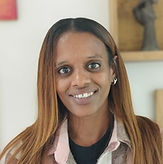
About Us
Olim Beyahad was founded in 2007 by Attorney Yifat Ovadia and Adva Hadar with the goal of promoting suitable employment integration among Ethiopian Israeli university graduates at the forefront of Israel’s workforce.
Over the years, we expanded our scope to include additional activities that advance our ultimate vision:
Changing Israeli society’s perceptions and negative stereotypes about Ethiopian Israelis
In order to fulfill this vision, we must work and strive to create a change in perceptions among influential figures and policy makers, as well as Israeli society as a whole.
There are currently about 155,000 Israelis of Ethiopian descent residing in Israel, 44% of whom are youth and children who were born in Israel.
Although about four decades have passed since the large waves of “Aliyah” from Ethiopia, and despite the many successes in various facets of life, the Ethiopian Israeli community continues to face many challenges.
The reality in 2020 is that Ethiopian Israelis still face both overt and covert discrimination, which prevents them from fulfilling their aspirations for personal, professional, and financial growth. While there was a relative improvement in various areas, data still clearly shows the many existing gaps between Ethiopian Israeli youth/young adults and their non-Ethiopian peers. In the field of education, the gap remains in students’ achievements – especially in core subjects (English and mathematics) and in their “Kaba” (quality index) scores determining their IDF placement, both of which significantly affect their professional futures. Over the years, there was a rise in the percentage of Ethiopian Israeli university and college students; however, their percentage among the general population is still low, while many of them major in fields that are not in high demand in the workforce or are accepted to lower-ranking academic institutions. In the area of employment, the percentage of Ethiopian Israelis employed in jobs requiring academic degrees is very low as compared to the general population. In addition, there are significant gaps in salaries and in the representation of Ethiopian Israelis in executive positions in Israel’s private and public sectors
Matriculation data
The eligibility rate for a matriculation certificate among Israeli students of Ethiopian descent is significantly lower than the rate among the general Israeli population.
44.8% of twelfth-grade students of Ethiopian descent received a matriculation certificate that meets the threshold requirements for universities, and they are potential candidates to continue their studies at institutions of higher education, in comparison with about two-thirds of all Israeli students. In addition, approximately 5% of twelfth-grade students of Ethiopian descent studied mathematics at the 5-unit level, in comparison with 21% of all Israeli students in 2019.
In study tracks that integrate mathematics with at least one scientific subject at the level of 5 units, there were only 4% of Ethiopian descent, in comparison with 18.5% of all Israeli students, a gap that is only increasing.
*From the Institute for Immigration and Social Integration at Ruppin Academic College.

Percentage who
take the matriculation
exams
Received a full
matriculation
certificate
Full matriculation
certificate that
meets the threshold
requirements for
universities
Israelis of Ethiopian descent
Total population
Employment
A relatively large number of Ethiopian Israelis major in the following fields: Social Sciences – 26% of Ethiopian Israeli students vs. 19% of students among the general population; Business Administration –
19% of Ethiopian Israeli students vs. 11% of all students. On the other hand, a relatively low number of Ethiopian Israelis major in the following fields: Engineering and Architecture –
11% of Ethiopian Israeli students vs. 19% of all students;
Natural Sciences – 4% of Ethiopian Israeli students vs. 11% of all students; Medicine – 0.5% of Ethiopian Israeli students vs. 1% of all students.
(Israel’s Central Bureau of Statistics, 2017)
Distribution of B.A. Students
According to Academic Institution –
Ethiopian Israelis vs. the general population, 2016-2017
Ethiopian Israeli students

All students

Employment
Employed in management positions
Employed at jobs requiring an academic degree
Over 50% gap between the average Israeli’s salary and the average salary among Ethiopian Israelis according to Israel’s Central Bureau of Statistics, 2018.

Employed persons according to occupations requiring academic degree and management positions

Out of all Ethiopian Israelis employed in the workforce
Out of all employed persons in the workforce
What Do We Do?
Higher education, employment, and the media serve as means to deal with the socioeconomic challenges faced by the Ethiopian Israeli community and change Israeli society’s rooted perceptions towards Ethiopian Israelis. As such, we work to expand the representation of talented young adults in the leading sectors in Israel’s workforce and society.

Higher Education
In the area of higher education, we guide Ethiopian Israelis – from middle school students through university students throughout the country – with the goal of preserving and promoting academic excellence and excellence in the arts and sports.

Employment
In the area of employment, we guide Ethiopian Israeli university and college graduates throughout the careers with the goal of increasing the percentage of Ethiopian Israelis employed in high-quality and leading jobs, as well as executive roles and key positions in Israel’s workforce. We do this through the operation of unique and innovative programs and strategic partnerships with the business, public,
and social sectors.

Media
We work to change the quantity, quality, and terminology of Israeli media content and portray Ethiopian Israelis in a way that will dramatically change misconceptions among nationwide consumers – and particularly influential figures and policy makers. We work with a network of leading Israeli media figures and institutions to promote the appropriate representation and coverage of the Ethiopian Israeli community, while integrating Ethiopian Israeli figures into media items and working to increase the number of Ethiopian Israeli media professionals. The model requires intensive long-term work to gradually and systematically change public consciousness.




_edited.jpg)















.jpeg)








































